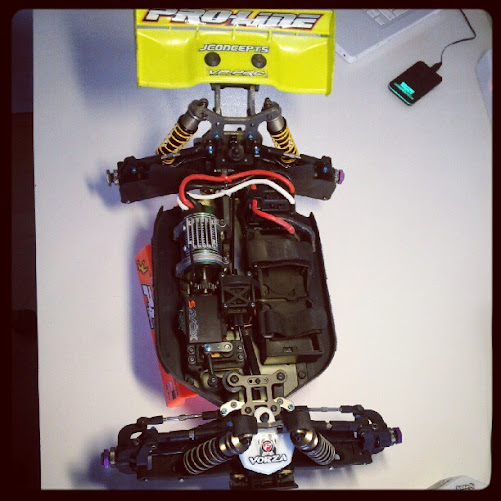Het R.O.A.R. reglement met betrekking tot de baan..
http://www.roarracing.com/downloads/2008_ROAR_Rule_Book.pdf
2 TRACK SPECIFICATIONS
2.1 BARRIERS
2.1.1 Barriers must be supported in such a manner that sharp contact will not cause them to fall
over or become ineffective, thus allowing cars to pass through an opening.
2.1.2 All barriers must be in good condition, not deteriorated by weather or other causes.
2.1.3 Permanent features of the race site, such as curbs or grassy areas, may be utilized.
2.1.4 Spectator control must be established at least five feet outside the barriers. For fuel onroad courses, control should be established at least ten feet outside the barriers. For 1/5-
scale courses, control should be established at least 25 feet from high-speed areas of the
track. 10
2.1.5 Minimum barrier specifications are as follows: (metal barriers may be substituted)
Class Outer barriers Inner Barriers
Thickness Height Material Thickness Height Material
1/12 and 1/10 onroad Electric
0.5” 3.5” Plywood 1.5” 3.5” Wood
2” diameter PVC Pipe
1/10 off-road Electric
and Fuel
0.5” 3.5” Plywood 3” diameter PVC Pipe
1/10 on-road Fuel 0.75” 7.5” Plywood 1.5” 3.5” Wood
1/8 off-road Fuel 0.75” 7.5” Plywood 3” diameter PVC Pipe
1/8 on-road Fuel 0.75” 7.5” Plywood 1.5” 3.5” Wood
1/5 on-road 0.75” 7.5” Plywood 1.5” 3.5” Wood
Electric oval 0.75” 11.875” Plywood 1.5” 3.5” Wood
Fuel Oval 0.75” 11.875” Plywood 1.5” 3.5” Wood
2.1.6 In addition to the barriers specified above, the following should be used to protect any
spectator areas:
• On road courses, the spectator areas in high speed portions of the track should be
separated by a catch fence. This should be wire fence or construction netting at least 24”
high, placed 5’ or more from the outer retaining wall.
• On 1/5-scale road courses, a three-foot high secondary barrier (catch fence), capable of
retaining a vehicle at speed, must be placed in all areas where the cars are traveling in
excess of 25mph. It must be positioned either behind the 10 inch outside barrier or
placed at a minimum of 16 inches from the marking lines of the track if no other outside
barrier is used. This barrier must be made of a material capable of stopping a 1/5-scale
vehicle.
2.1.7 All barriers, portable or permanent, should be linked in such a manner that they present a
surface toward the track that will not damage a vehicle if it makes contact in a grazing
manner while proceeding around the track. Overlapping of barriers must always be away
from the direction of travel.
2.1.8 A positive means of stopping a vehicle that leaves the racing surface must be provided.
2.1.9 Supplemental barriers sufficient to stop a vehicle must be placed in any area where
swinging wide or loss of control could result in a vehicle going beyond the outer retaining
barrier. Such barriers should be no closer than 18" to any portion of the racing surface.
2.1.10 The outer limits of the track must have barriers that will prevent cars from leaving the
racing surface under normal racing conditions. These barriers must be easily
distinguishable to the drivers.
2.1.11 Lanes must be sufficiently separated by either natural or artificial barriers to prevent cars
from crossing into oncoming traffic. Where tracks have multiple layouts, those sections
not in use must be separated from the racing configuration by barriers or other deterrents
that prevent cars from using these sections.
2.1.12 Tapered boards, highway dots, or similar deterrents should be placed approximately 6"
inside the inner-boundary turn markings to discourage corner cutting. Such devices may
not be higher than 2" and must be tapered to allow cars to ride over them. They should be
firmly secured to prevent movement onto the racing surface. 11
2.1.13 No device may be used on a high-speed portion of the track or at the end of a high speed
straightaway that may cause a vehicle to be launched upward if struck. Plow discs or
similar devices may not be used at the end of high-speed straights.

